Commentary &Disney &Frame Grabs 13 Jun 2011 06:33 am
Peter Pan Multiplane
- I had remembered Peter Pan as utilizing the multiplane camera quite a bit to set up the show. In the most obvious ways, where I thought they used the camera, I was wrong. There’s, of course, the one famous flying scene with Peter, Tink and the family over lots of clouds. But other shots of London and the opening of the house are not dimensional. They were painted on one level.
In a way, this film, despite the success of Cinderella, is an equally austere production. Gone are the days of Pinocchio and Fantasia where the multiplane camera was enormously effective and often used. Hello to the days of tight budgets.
Let’s take a look.

This is the opening once we hit London (down from a star).
We pan from London to the fog.
No multiplane camera use is evident. It’s a single-level Bg.
Dissolve to
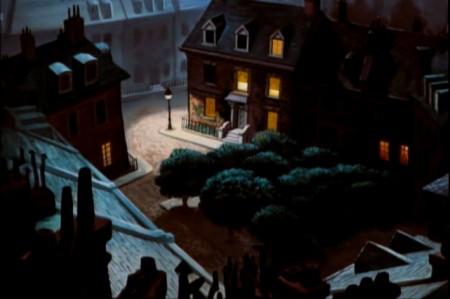 1
1
The Darling townhouse. Camera trucks in slowly.
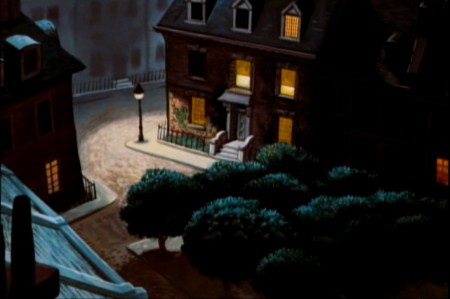 2
2
There are no separate levels, no use of the multiplane.
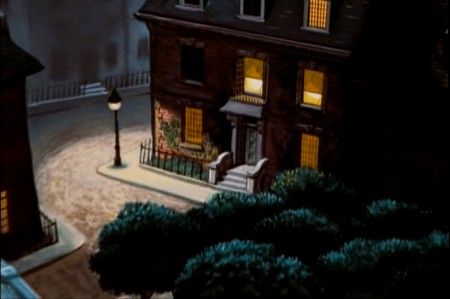 3
3
This is disappointing given how good the similar scene which opens
101 Dalmatians looks using a simple multiplane setup.
Once inside the Darling household there is no obvious use of the multiplane.
The next scene to question starts as Mr. & Mrs. Darling prepare to go off to their party leaving the children behind.
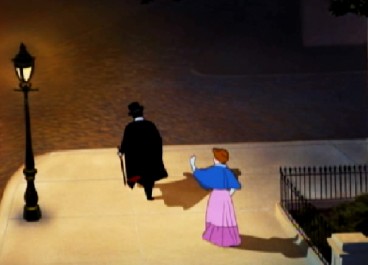
This next pan starts at the base as the Darlings
walk away from the camera into the distance.
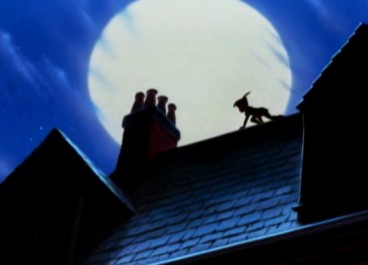
We pan up to the rooftop to see Peter Pan in silhouette.
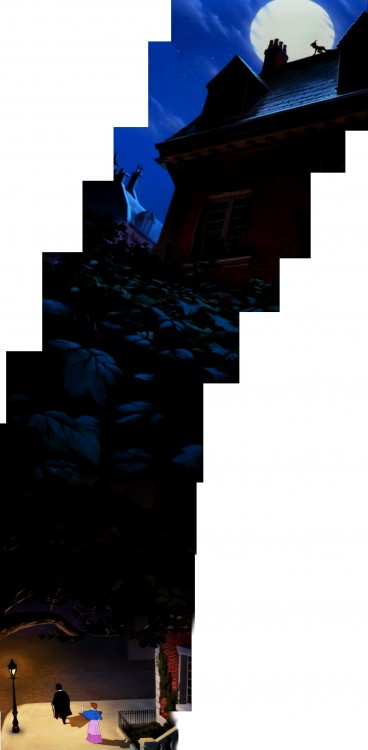
This is the full Bg.
There is no use of the multiplane camera.
Nor are there separate levels – it’s all one piece.
So, it would seem that the multiplane has not been used to this point.
The big flying scene comes just as they’re about to fly out of London and on to Neverland. It serves as the bridge from everyday life on to the magical land of Peter Pan. You need something big here, and they’ve got it – one of the biggest multiplane scenes ever. The layout for this scene is extraordinary, and the animation couldn’t be better. It’s quite a scene.
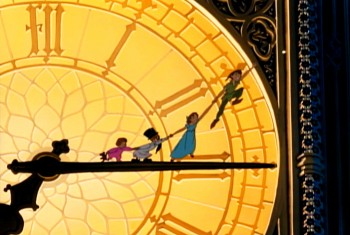 1
1We cut from this shot of the clock.
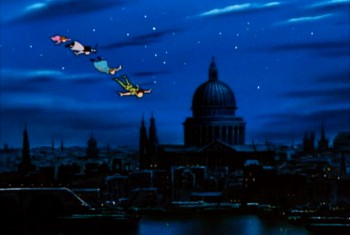 2
2
Peter & gang fly over clouds on flat Bg.
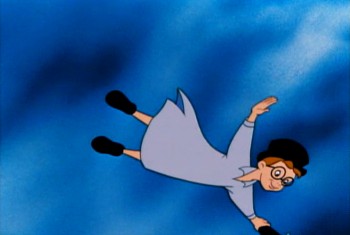 11
11
All done with some brilliant animation.
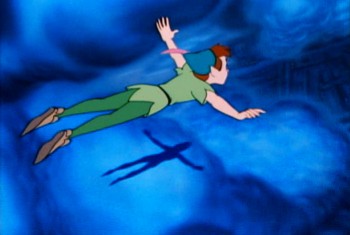 21
21
Suddenly the bottom drops out and it’s multiplane.
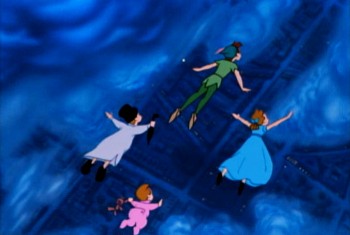 25
25
The camera also turns to have the characters flying North.
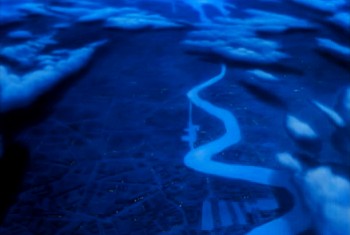 31
31
The camera zooms past them . . .
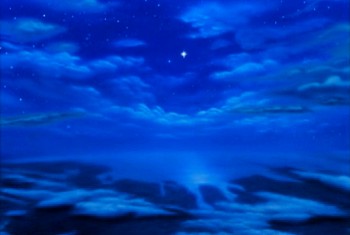 32
32
. . . and moves up to star.
There are one or two other small uses of the multiplane camera on Neverland. Typical of these is this shot of the Indian Village. As we pull in, only the sky is separated and allowed to go out of focus as the camera moves in.
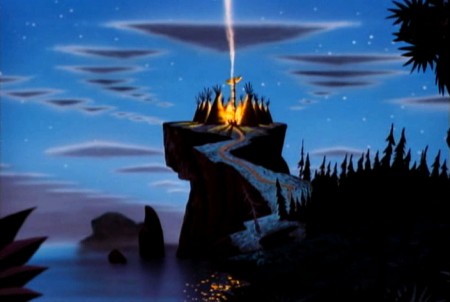
.
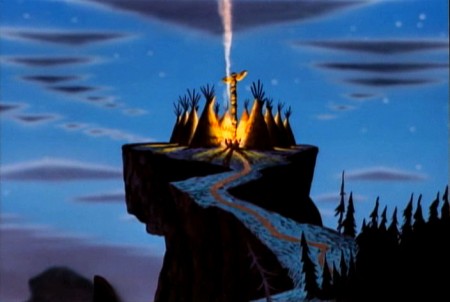
But basically that would seem to be it for the use of the multiplane camera in the film. There’s the one big scene, the flying scene, which shows it off as well as any scene to that point in Disney animation, and a couple of other much smaller scenes.
But on second look we find that there was some use of it in the nursery.
The Bgs contain stripes and obviously brought some concern that there would be strobing, especially in cutting from one set of stripes to another – one CU to another.
It appears to me that they put the Bgs for the closeups out of focus by putting them on a lower level of the multiplane camera and shot the characters in focus. It’s a simple trick (given there were no camera moves) that didn’t up the budget very much.
AfterNote: I am wrong about this. Milt Gray, in the comments section, had proof that the Bgs were painted with Airbrush to soften them.
I’d recently read that they were thinking of utilizing this trick at one point in Cinderella. They ultimately decided against it. (I think it was an interview with Wilfred Jackson, but I haven’t located that reference quickly. When I do, I’ll put the quote in here.)
Here are a number of examples:
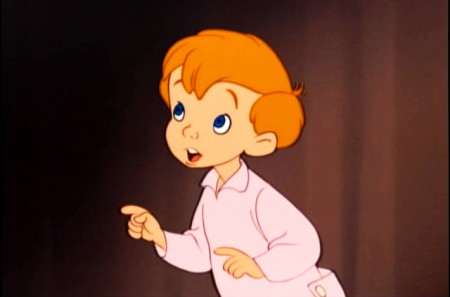 1
1There’s a soft focus on the Bg – not very extreme.
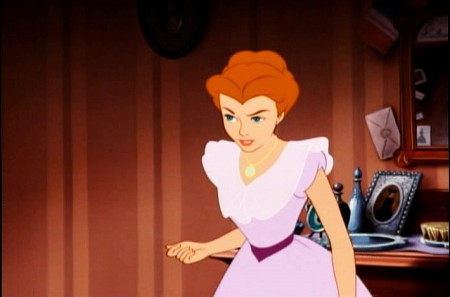 2
2
We go from this half-shot leaving the shot in focus . . .
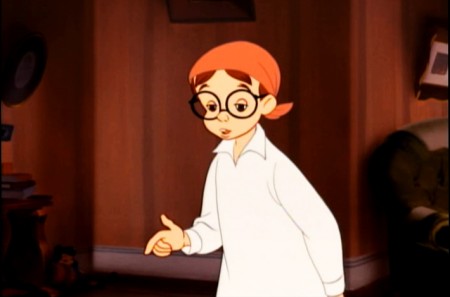 3
3
. . . to this shot of John where the focus is soft.
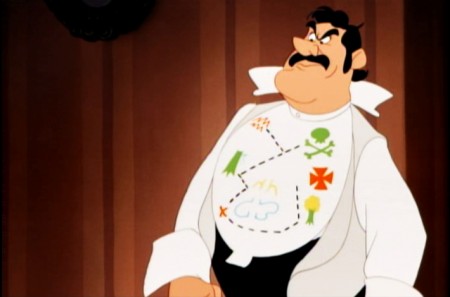 4
4
Father stands, here, with an in-focus Bg.
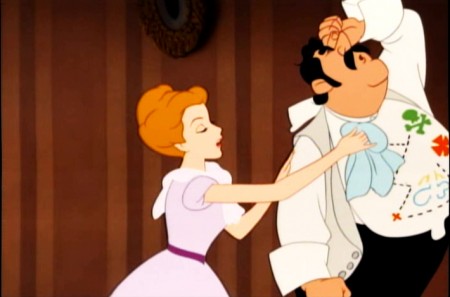 6
6
Back to the parents with the Bg still in focus.
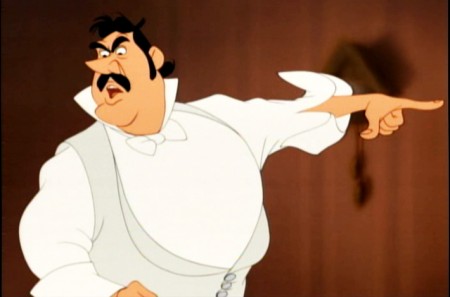 8
8
Now father stands against a very soft Bg.
It probably didn’t work cutting back and forth with the Bgs in focus.
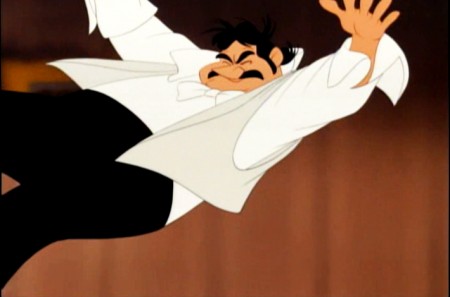 9
9
This scene is the only one with a big camera move as . . .
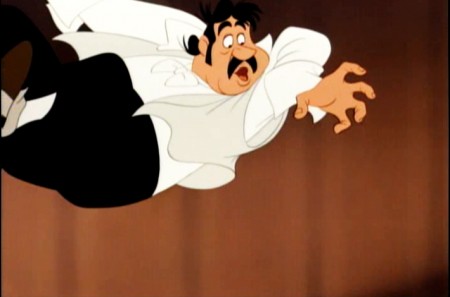 10
10
. . . father flies across the room and . . .
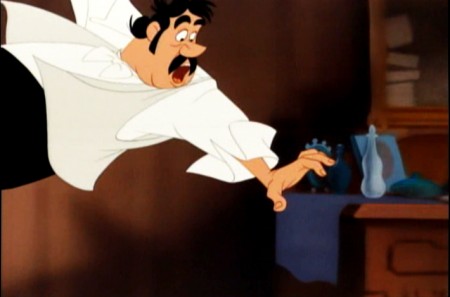 11
11
. . . hits a night table.
The stripes are out of focus. The foreground night table is
in focus, meaning it would be on the same level as father.
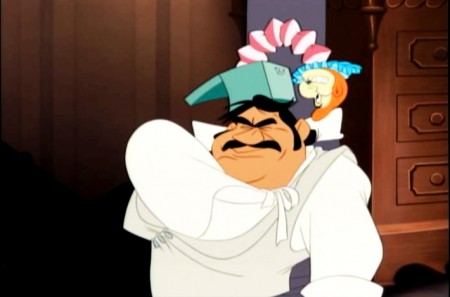 12
12
The finish comes a couple of scenes later. It’s all, now, in focus.
Back in the nursery at the end of the film, the soft focus comes back in two or three short scenes.
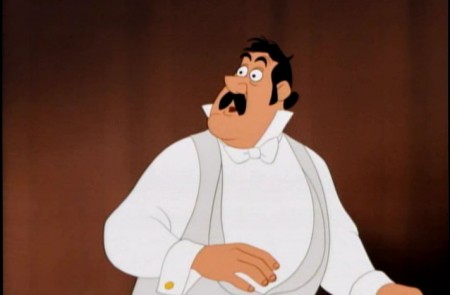
This shot of the father is typical of the soft Bgs. They seem to build
from in-focus to getting softer and softer (behind father) as he realizes
that he’s “seen that ship before.”
Many of the other shots at this point are in focus.
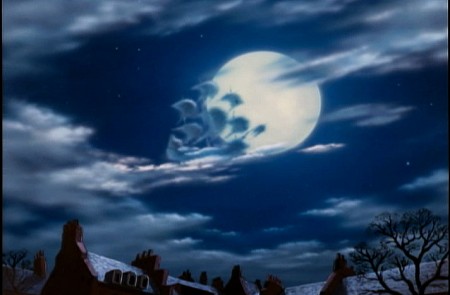
I wonder, in this shot, if the ship were on another level so that it would read soft.
This scene has such magic in it, somehow I think they HAD to use the multiplane camera.
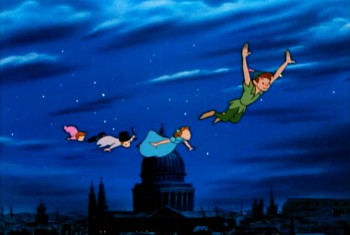
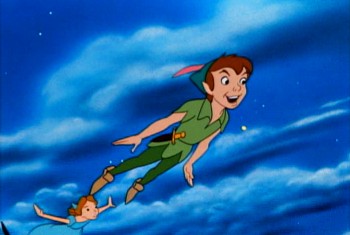
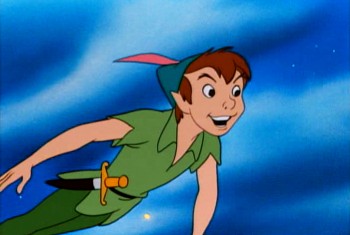
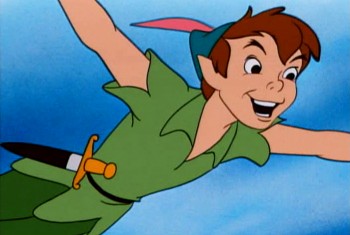
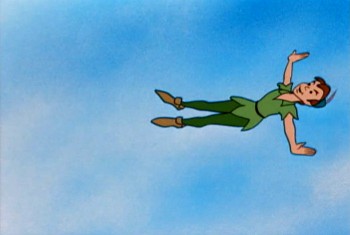
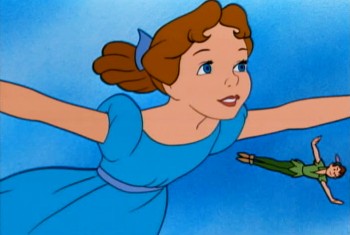
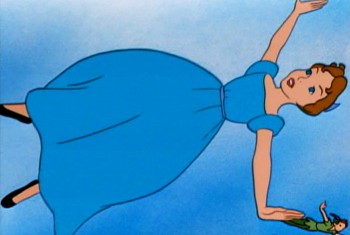
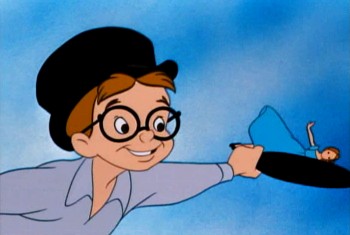
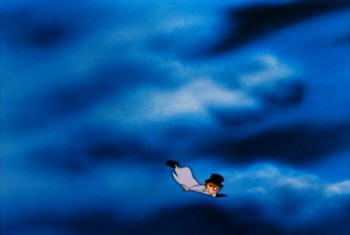
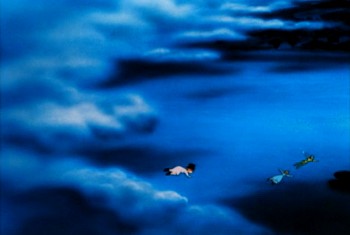
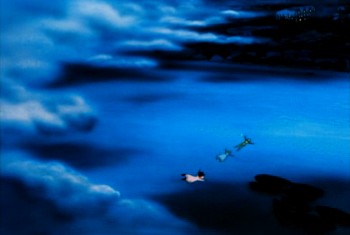
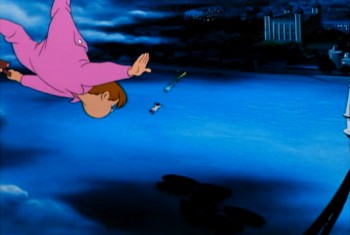
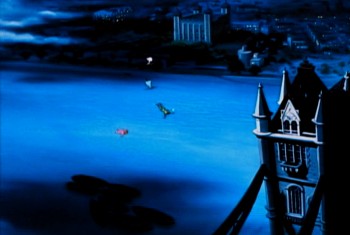
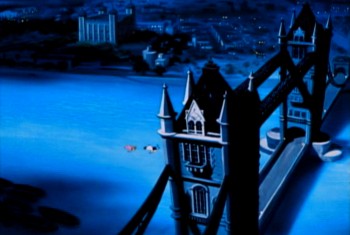
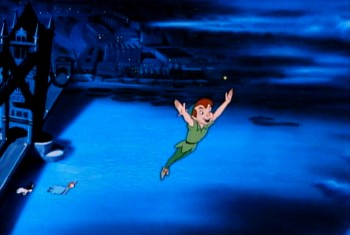
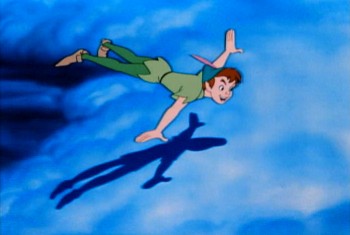
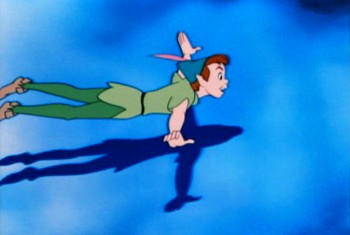
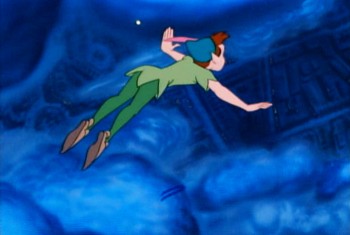
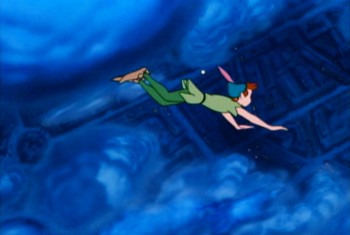
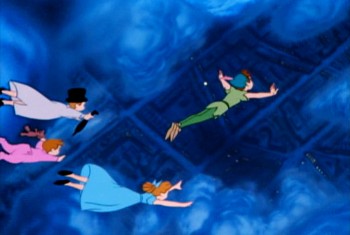
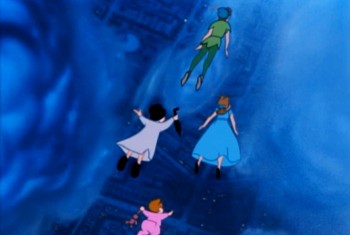
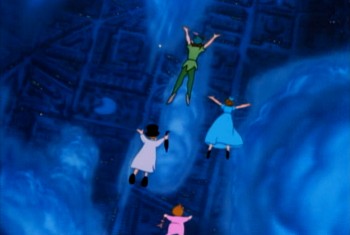
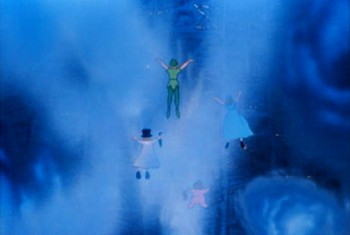
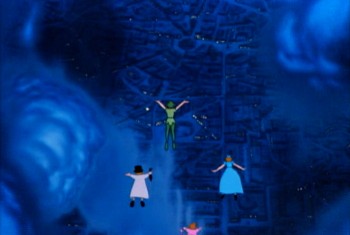
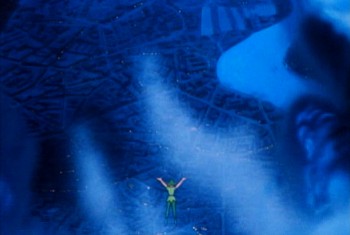


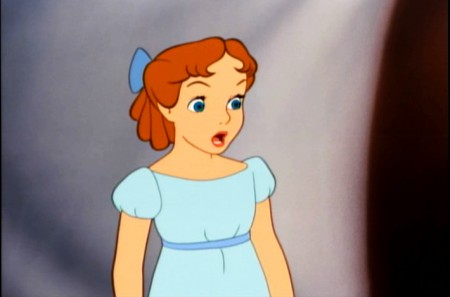
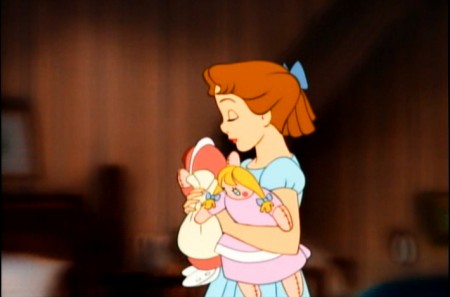

on 13 Jun 2011 at 7:26 am 1.Stephen Macquignon said …
I love the richness and depth that a multiplane can create
on 13 Jun 2011 at 8:55 am 2.Sandro Cleuzo said …
No matter what can be done these days moving the camera with CGI, the flying over London to me is the best animation camera work and scene planning I have ever seen, just perfect!
Those guys were amazing.
on 13 Jun 2011 at 1:25 pm 3.Milton Gray said …
Hi Michael — Your assumptions about the multiplane scenes in Peter Pan are perfectly reasonable, and for years I had assumed the same. But then in the mid 1970s Mike Barrier sent me out to interview several of the older Disney artists, including the artist who drew the layouts for the scene you mentioned of Peter Pan and the kids flying over London. I’m embarrassed that I can’t remember right now which artist that was, even though I still vividly remember sitting in his home and what he and I both said. But I was shocked when he told me that that scene was shot “flat” as he called it — it was not shot multiplane! Instead, the different levels were painted “soft” with airbrush, to look “out of focus”, and were panned under the camera at different speeds to complete the multiplane look. I asked him a few different questions about that, to be sure that I wasn’t misunderstanding or that he wasn’t confusing this with something else, but he was very clear about it, and added that he was particularly proud of having simulated a multiplane look so well without real multiplane. Likewise the “out of focus” backgrounds in the kids’ bedroom were painted “soft” with airbrush, and shot “flat” under the camera. Sometime later I saw the actual original background of a scene in the back yard, where the father, George, wants to tie a rope to the dog, Nana, and indeed the background, of a brick wall with lots of detail, was painted “soft” with airbrush. I don’t know how anybody could even do that, but I actually held it in my hands and saw it.
on 13 Jun 2011 at 2:47 pm 4.Michael said …
I’m surprised that you’re saying they painted the out of focus scenes and didn’t shoot them on the multiplane camera. There’s such a slow build from in focus to out of focus that I was sure they had put the Bgs soft using the multiplane camera – especially after I’d just read the suggestion of this in an interview for Cinderella. But then in the Cinderella problem they had already painted the Bgs and knew they were going to be a problem, and the suggestion of softening them under the multiplane camera seemed a reasonable idea to me. Guess I was wrong.
on 13 Jun 2011 at 2:56 pm 5.John Celestri said …
Michael,
The multiplane-ish scene of Peter and the gang flying over London and in to the distance, has a very special place in my heart. It was watching this very scene during a screening of Peter Pan in 1973 at Alice Tully Hall (Walt Disney’s 50th Anniversary Film Retrospective) that sparked my desire to become an animator.
on 13 Jun 2011 at 3:29 pm 6.Michael said …
John, the very end of this scene where the bottomless clouds fly under the group is one of the strongest multiplane scenes ever done. The fact that it comes at the tail end of a very long scene that doesn’t use the multiplane camera is a miracle of layout. I’m even more in awe of it after producing these frame grabs and watching the scene frame by frame. It’s the full essence of the magic of this film.
on 14 Jun 2011 at 11:47 am 7.David Nethery said …
Milt Gray – If you remember the name of the layout artist you interviewed please come back and post again. (was the artist Ken O’Connor perhaps ?) Your comments about this shot are very interesting as I too had always assumed this shot was the result of using the magical multiplane camera , but if this shot is made by panning “flat” art at different pan speeds to simulate the multiplane (with some levels painted varying degrees of soft focus) I’m even more in awe of the layout and scene planning involved. This shot never fails to take my breath away.
Too bad that most people have never had an opportunity to see it on a big screen. I’m glad that I grew up in the 1970′s when Disney was still regularly re-releasing their features to theaters. I’m pretty sure I saw almost all of the Disney animated features at least 3 or 4 times on a big screen when I was a kid and that made a lasting impression. (later on when I worked at Disney I filled in the gaps with studio screenings of most of these films I had seen in my younger days, including some of the ones I had never seen on a big screen like “The Three Cabelleros” or “Melody Time”) Whenever those films would come to my town I would try to sit through at least two screenings and go back again the next day to watch them again if possible. I appreciate having the easy access to the films on DVD , but unfortunately the home video marketing killed off the motivation to re-release the films theatrically. The easy access on DVD has made everyone feel like these films are “common” and that they’ve seen it all , but if someone hasn’t seen films like Peter Pan on a big-screen then I say : “you haven’t really seen it all.”
on 14 Jun 2011 at 11:56 am 8.David Nethery said …
The other source for viewing these films on a (semi) large screen that has disappeared from the culture is the 16mm print distribution system Disney had for schools , churches, and other civic organizations to screen the films. I remember also being able to see a number of the Disney films in some school auditorium or church social hall . Screenings of 16mm prints wasn’t quite as good as seeing an official 35mm theatrical release , but still good and the effect of watching the films projected up large in a dark room is something magical that has stuck with me.
on 14 Jun 2011 at 12:01 pm 9.Michael said …
David, Just to make sure there’s no confusion, the big flying scene is flat until the very last part of the scene when it defintiely goes to multiplane for the many layers of clouds. They talk about this shot in the original ART OF ANMATION by Bob Thomas and call it one of the more expensive multiplane shots.
All of the shots of panning scenes (over London, outside of the Darling house, sidewalk to Peter on the roof) prior to this one shot are done flat with some airbrush softening.
on 14 Jun 2011 at 12:04 pm 10.The Gee said …
http://www.youtube.com/watch?v=YdHTlUGN1zw
It is Walt D. explaining the multiplane camera. From 1957…..
Oddly enough, I just ran across the link on a non-animation site which the site’s blogger found on an non-animation site.
Odd coincidence, I guess.
on 14 Jun 2011 at 4:57 pm 11.David Nethery said …
“They talk about this shot in the original ART OF ANMATION by Bob Thomas and call it one of the more expensive multiplane shots.”
Yes, I had always assumed that shot was multiplane.
What has me a little confused is Milton Gray’s post up above (Post # 3) where he recalled speaking with a Disney layout artist who claimed that the shot in question was only simulated multiplane, actually done with “flat” art panned at different pan speeds, with varying degrees of soft focus on some layers. (I was asking Milt for more details if he remembered the layout artist’s name and expressing my amazement IF that shot was not in fact a true multiplane shot. )
on 14 Jun 2011 at 11:53 pm 12.Tom Minton said …
The non-multiplane segment of that Peter Pan flying shot goes on for an amazingly long time without a cut. Perhaps this was meant as a visual build up so that the sudden multiplane effect would have maximum impact. It certainly does. I remember the days of 16mm IB Tech prints of Disney features and shorts, meant for the educational market and such. The Technicolor lab did great work in 16mm reduction printing prior to dismantling the three strip process in the 1970′s.
on 15 Jun 2011 at 11:56 am 13.Milton Gray said …
Michael — You are certainly correct (I just looked it up) that the original ART OF ANIMATION by Bob Thomas, on page 125, does site the scene in question, of Peter Pan and the kids flying through the clouds over London, as a multiplane scene. I just now took another careful look at the scene, and two things caught my attention: On the one hand, the animation of the flight between the clouds over London could have been shot flat, as the Disney artist claimed, because all the elements are just moving sideways — however in the last few seconds, when the camera moves up toward the stars, the foreground clouds become larger relative to the rest of the sky, which would have to require a multiplane camera. And if the multiplane camera were to be used in that scene at all, then why not also for the part in question? Perhaps to save as much cost as possible, considering the extreme difficulties of shooting multiplane (due largely to the balance of lighting of the levels, oddly enough). In trying to guess which artist it was who told me about this, I’ve narrowed the probabilities down to either John Hench or McLaren Stewart (David — I know it was not Ken O’Conner). Well, all these years since the mid 1970s I’ve regarded this scene in awe, as the greatest multiplane scene not shot on the multiplane camera, but now I have to question the whole thing again. But thanks, guys, for challenging this issue — I’m always interested to learn something new.
on 15 Jun 2011 at 1:47 pm 14.Michael said …
Well, that gives me heart. I wanted to believe it was a multiplane scene.
I WAS taken by how much of the scene was flat and only the last few seconds in multiplane. It’s an extraordinary scene for the layout, alone. The animation of the characters is also off the wall, even though there is no real acting required. Just a lot of beautifully planned movement.
on 15 Jun 2011 at 2:32 pm 15.Jonna said …
I can only imagine how it would have been to see one of the classics at a theater (I was born in the 90′s). It would have been great fun if any of you told about a premiere or screening that you’ve attended (e.g. the first time you saw Sleeping Beauty or something).
on 15 Jun 2011 at 4:39 pm 16.Michael said …
On Saturday, I’ll give a couple of stories aout attending some of these features as a child.
on 17 Jun 2011 at 1:45 pm 17.Stephen Perry said …
I Have a copy of the Final Draft of Peter Pan. Here are the list of Multiplane scenes:
Seq01, sc 1&2 are both multilpane, sc9, truck in through window.
Seq03, sc40 Flying over London. (Larson)
Seq04, sc19.1, pirate singing on yard arm. (Nordberg)
sc28.5, bubbles from Croc. (Nordberg) Sc29.3, Croc climbs onto rock. (Nordberg)
Seq09, (Hook has a cold), sc1 truck in on pirate ship, sc2, Croc swimming around, sc3, Hook shivering, “That cursed Peter Pan”.
Seq10, truck in on Indian village, not down as multiplane?
seq14, (fight with pirates), sc12, no ripples, pan down to water, sc79, Hook climbs rigging.
Seq15, (voyage home), sc65, cloud ship in sky, not down as muliplane, sc70, pull back from Darling home.
The end.
Maybe the layout artist Macstewart had a laps in memory?
on 17 Jun 2011 at 6:41 pm 18.Stephen Perry said …
One other thing, once the animation was done the whole scene moved into the scene planning dept. And Maclaren may have laid it out as a flat pan, but once in the scene planning dept it was changed to multplane? Maybe the had a single plane that attached to the rostrum camera for shooting artwork truck in’s like the Indian village and so wasn’t shot on the multiplane and not noted as such on the draft?